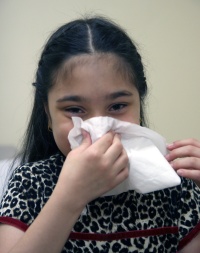What are the symptoms of asthma?
- Wheezing
- Rapid breathing
- Labored breathing
- Gasping
- Difficulty breathing when exercising
- Chest tightness
- Prolonged exhalation
- Chronic cough (especially at night)
- Lingering cough and shortness of breath after common cold
Asthma FAQ’s
Science of Asthma
Your child’s lungs have two main jobs:
- Take in oxygen from the air
- Get rid of carbon dioxide from the body
Air goes down the trachea and into the lungs through bronchial tubes. Muscle bands wrap around these tubes. Inside the lungs are small air sacs called alveoli. In these sacs, oxygen is exchanged for carbon dioxide. During normal breathing, muscles surrounding airways are relaxed, and air moves freely. During an asthma flare-up, your child’s body is not getting enough oxygen because –
- Airways swell. The lining of the bronchial tubes becomes inflamed and swollen reducing the space available for airflow.
- Airways tighten. The muscles surrounding the bronchial tubes tighten (bronchoconstriction) resulting in reduced airflow.
- Airways clog. The lining of the bronchial tubes increases mucus production, clogging airflow.
What are the kinds of asthma tests?
You probably remember when your child was first diagnosed with asthma, but do you remember the last time your child had an asthma check-up visit the doctor?
It’s essential for your child’s health and the quality of their life to have regular visits with the doctor to discuss asthma and review how the current treatment plan is working.
The possible tests for your child’s asthma are:
- Spiro meter – checks for narrowing in your child’s bronchial tubes. It measures how much air comes out of the lungs during exhalation after taking a deep breath.
- Peak flow – indicates if your child’s bronchial tubes are open, or constricted and inflamed. The doctor may recommend you check your child’s peak flow reading daily with a device called a peak flow meter.
A closer look at your child's asthma
The following stages may be used to diagnose your child’s asthma or to determine which treatment, or combination of treatments, is best for your child.
- Mild intermittent – symptoms come and go; your child has symptoms less than two days a week and two nights a month.
- Mild persistent – your child has symptoms more than twice a week and more than two nights a month but, no more than one time each day; the flare-ups may affect activity.
- Moderate persistent – your child has symptoms every day and more than one night a week; the flare-ups affect activity.
- Severe persistent – your child has symptoms throughout the day on most days and frequently at night; physic activity is limited.
Treating asthma
The first step toward treating asthma is avoiding triggers. But, you won’t always be able to keep your child away from the triggers. In addition, your child’s doctor may recommend medicine. There are two types of medicine:
- Long-term controller medicines – help reduce inflammation and tightening in your child’s airways to prevent asthma symptoms. They include: inhaled corticosteroids, long-acting bronchodilators, and long-term controller medications, called leukotriene blockers.
- Quick-relief rescue medicines – work quickly to open the airways by relaxing airway muscles; but, they don’t help prevent future attacks. These inhaled, fast-acting bronchodilators, also known as fast-acting inhalers or puffers, are for sudden asthma symptoms.
How do I know if my child needs a preventive medicine?
The doctor can recommend treatment options that are best for your child and the type of asthma being dealt with. Preventive medicines work over time to reduce swelling in your child’s lungs, helping your child to have fewer symptoms and flare-ups. Preventive medicines can also help decrease your child’s reactions to some triggers. However, for a preventive medicine to work effectively, your child needs to take it every day, even if symptoms are not being experienced.
Keep in mind that even though a preventive medicine is prescribed, a quick-relief medicine for flare-ups is also necessary.
Does my child have to take a steroid medicine?
Treatment options vary depending on your child’s type of asthma. Inhaled corticosteroids can be a first line of defense; but there are also these non-steroid preventive medicines:
- Leukotriene blockers – block leukotrienes, substances that are associated with the inflammatory process of asthma to help keep your child’s airways open.
- Long-acting bronchodilators – relax muscles surrounding the airways
At Welcome Pediatrics, we will work with you to find the right treatment for your child.
Managing Asthma
How do I know if my child's asthma is controlled?
Controlled asthma means having fewer symptoms so asthma doesn’t interfere with daily activities or with sleeping at night. If your child’s asthma isn’t controlled, or your child is having frequent flare-ups, talk to the doctor immediately.
What are the signs of a flare-up?
The signs of an asthma flare-up vary from child to child and can be different with each episode. They include –
- Changes in breathing (fast breathing, pused-lip breathing, etc.)
- Peak flow numbers getting lower
- Unusual paleness or sweating
- Hunched-over body posture
- Grumpy or easily upset
- Coughing
- Glassy look to eyes
- Heart beating faster
- Change in mucus
- Feeling weak or tired
Common Asthma Triggers
Certain things can bring on an asthma flare-up. These are called asthma triggers. Not all children with asthma share the same triggers. Keep track of when your child has flare-ups and what was going on at the time. This may help you pinpoint your child’s triggers.
Once you’ve identified your child’s triggers, try to avoid things that make it harder for the child to breathe. Also –
- Avoid smoke and don’t allow smoking in your home.
- If air pollution is bad, minimize the time your child spends outdoors by monitoring local weather reports or checking online to determine if pollution is particularly bad in your area.
Triggers may include:
- Upper respiratory infections – cold and flu, bronchitis or sinus infections.
- Irritants – cigarette smoke, wood smoke, marijuana smoke, strong odors such as perfumes or cleaning agents, air pollution or fumes.
- Weather – cold air, changes in temperature and humidity.
- Certain medications – aspirin, non-steroidal and anti-inflammatory drugs.
- Exercise – running can trigger an episode in more than 80% of children with asthma. Other physical activities can also trigger a flare-up.
- Strong displays of emotion – anxiety, crying yelling and laughing hard (these involve deep rapid breathing, which can trigger a flare-up).
- Allergens – many children with asthma have allergic asthma. Alergens such as pollen, mold, pet dander or dust worsen asthma symptoms.
Can my child be active and play sports with asthma?
Yes. Exercise is important to your child’s overall health – including the health of his lungs. But, first you need to talk to the doctor to make sure your child’s asthma is controlled.
Some children only have asthma symptoms when they are active or exercising. This is called an exercise-induced asthma flare up. It is very important to monitor asthma flare-ups while exercising, so talk to the doctor as soon as possible.
How are asthma and allergies related?
Allergies can cause or trigger asthma symptoms. If your child has allergic asthma, allerens, such as pollen, mold or dust mites, cause the lungs’ airways to react, resulting in asthma symptoms. Allergies and asthma are related, but they are not the same condition. Allergy symptoms can come and go, but asthma is a condition that your child will always have. If your child has asthma and allergies, it is crucial to treat manage both conditions.
Signs of an asthma emergency
- Wheeze, cough or shortness of breath gets worse, even after using a rescue medicine.
- Chest and neck are pulled or sucked in with each breath.
- Trouble walking or talking because of asthma symptoms.
- Peak flow rate drops to 50 percent or les than your child’s best rate, and does not improve even after using rescue medicine.
- Lips or fingernails are gray or blue.
IF YOUR CHILD IS EXPERIENCING ANY ONE OR MORE OF THESE SYMPTOMS CALL EMERGENCY MEDICAL CARE IMMEDIATELY (Dial 911)
Asthma Action Plan
At Welcome Pediatrics we will help you create an asthma action plan. You will have to share this plan with your child and caregivers, including teachers, coaches and family members. The goal of the plan will be to reduce symptoms and prevent flare-ups. We will work with you to develop: peak flow numbers, signs and symptoms, flare-up triggers and how to avoid these triggers, step-by-step instructions for handling flare-ups, prescribe medication if necessary, and specify instructions about using a rescue inhaler.

Come see our friendly doctors and staff at our Pediactrics-only facility in the heart of Brooklyn, NY!

Office Schedule
(hours variable during COVID19)
Monday ............... 11AM-6PM
Tuesday ............... 11AM-6PM
Wednesday ......... 11AM-6PM
Thursday ............. 11AM-6PM
Friday ................... 10AM-5PM
Saturday .............. Closed
Sunday ................. 10AM-4PM
